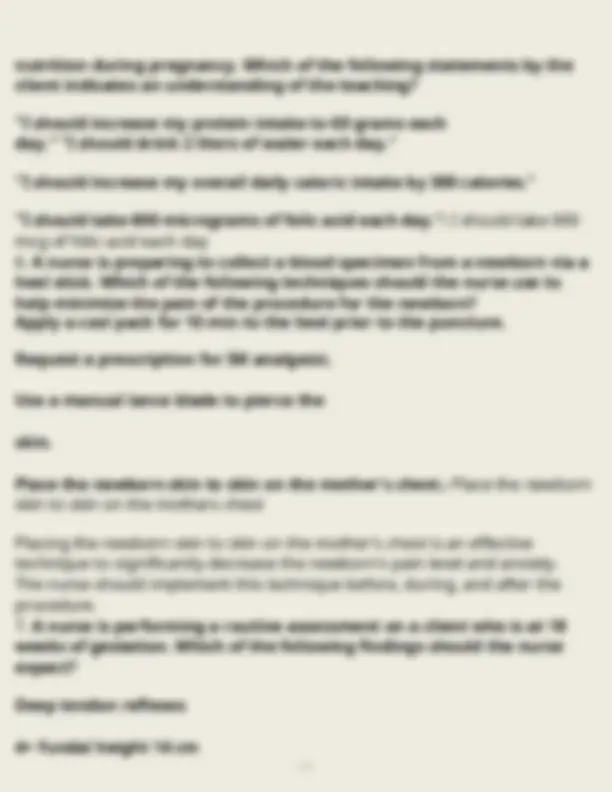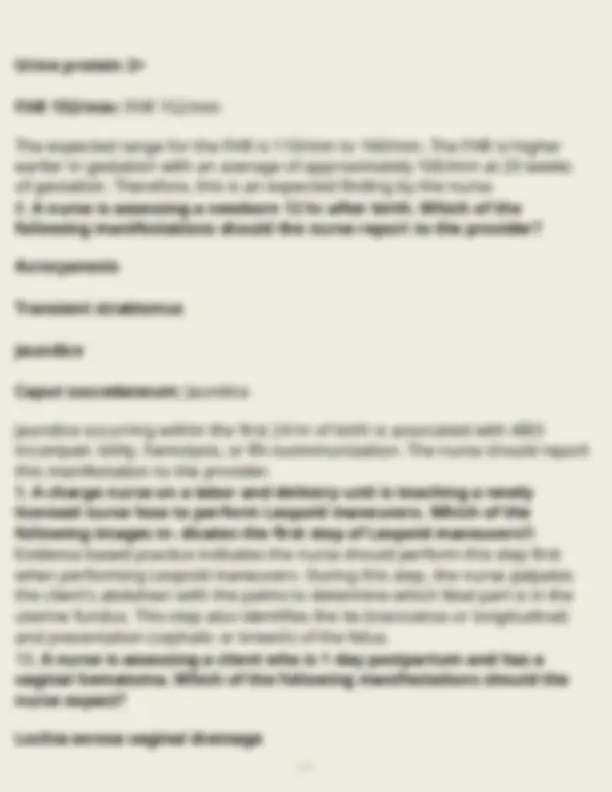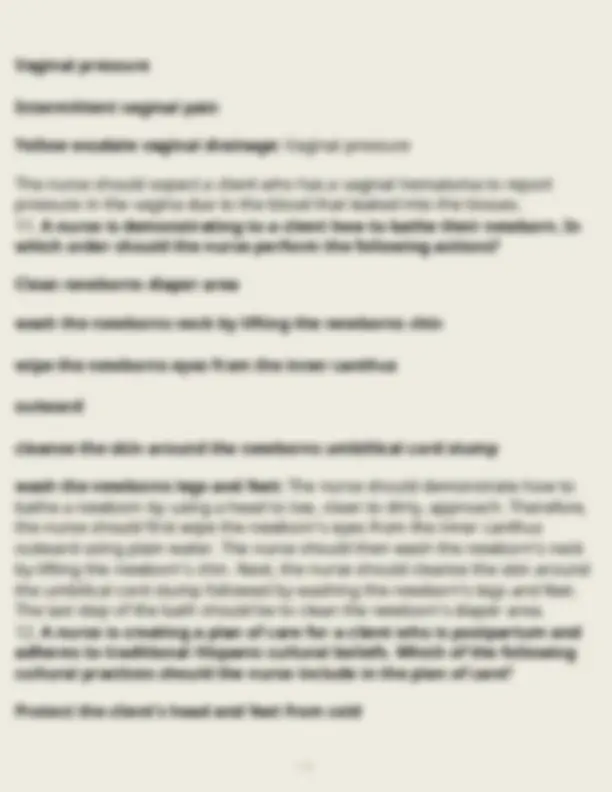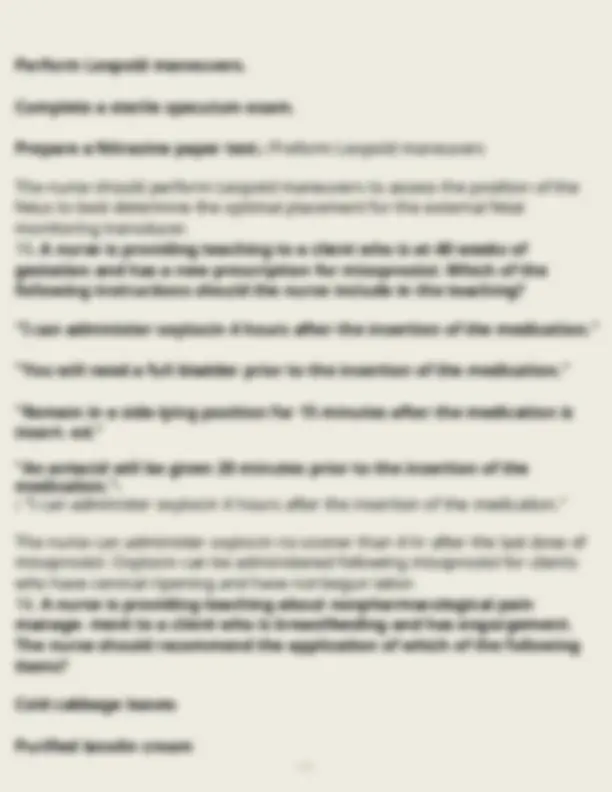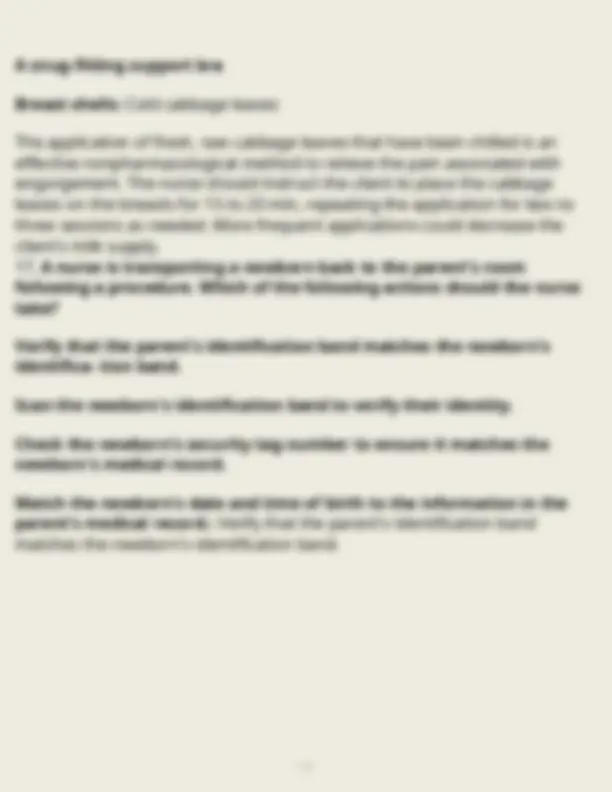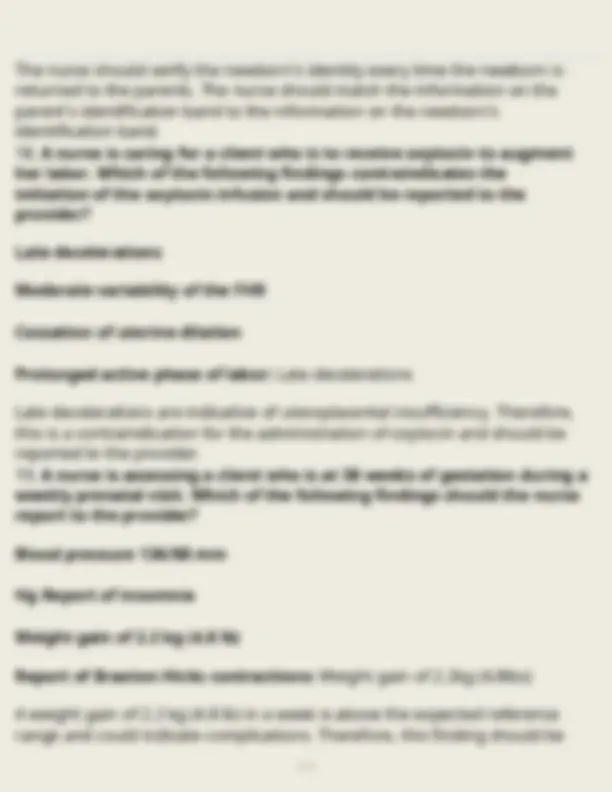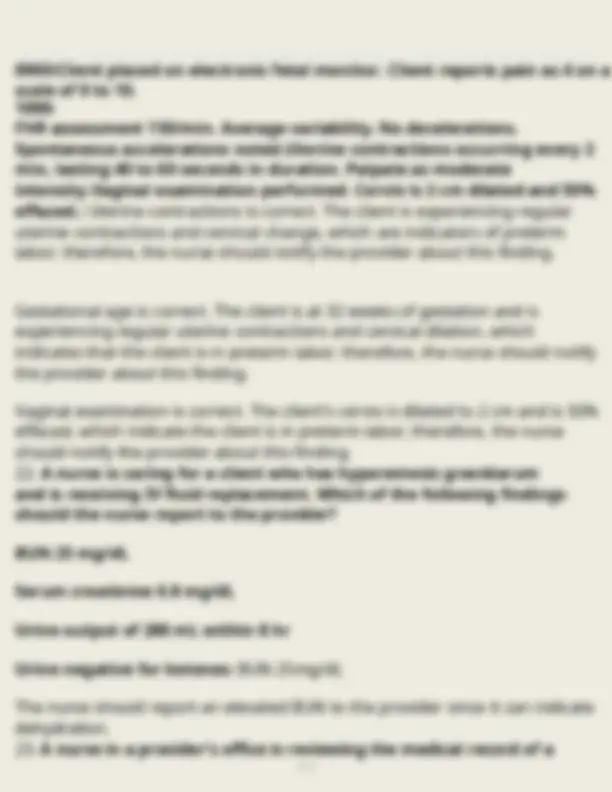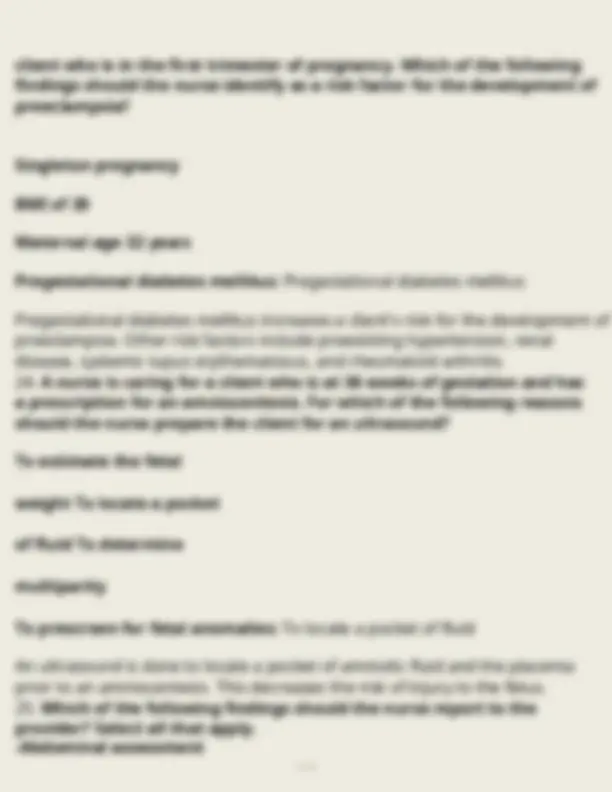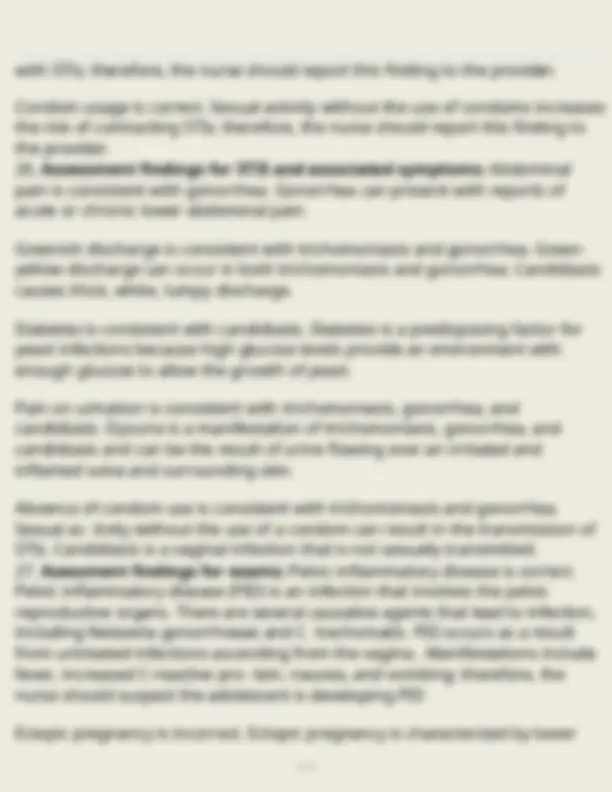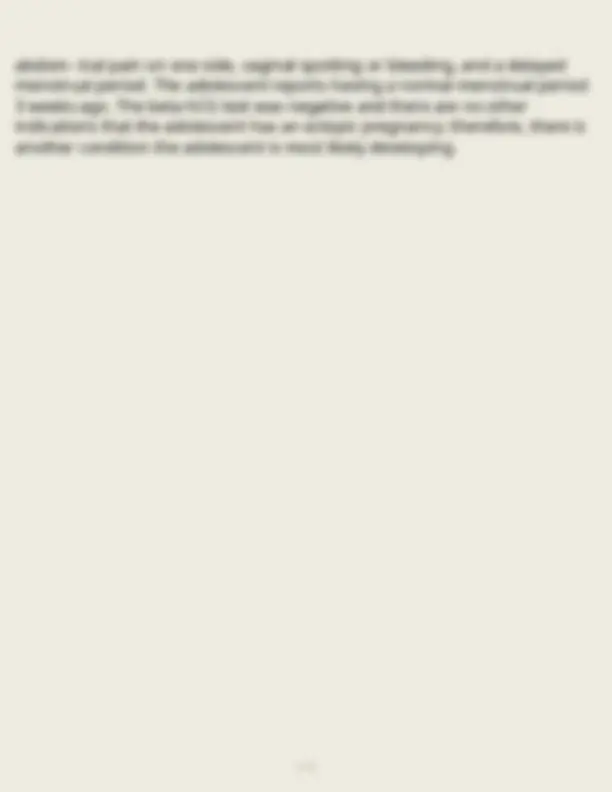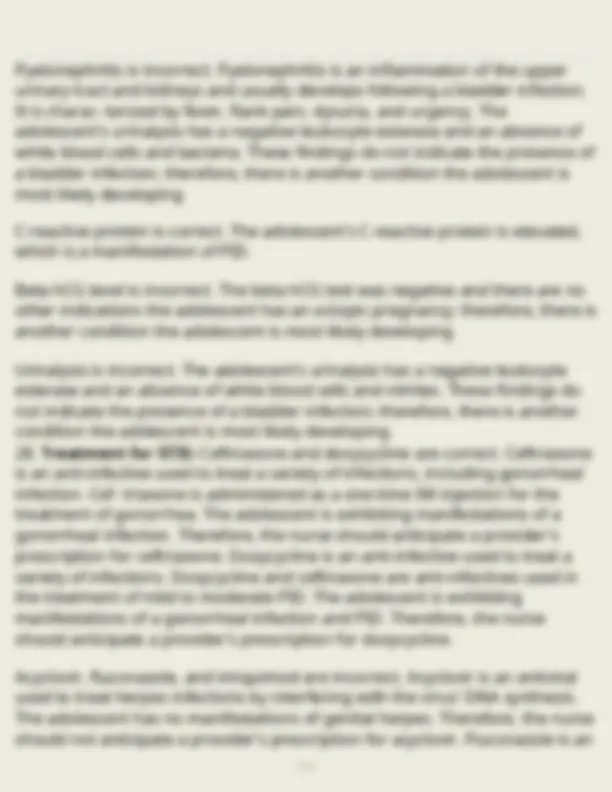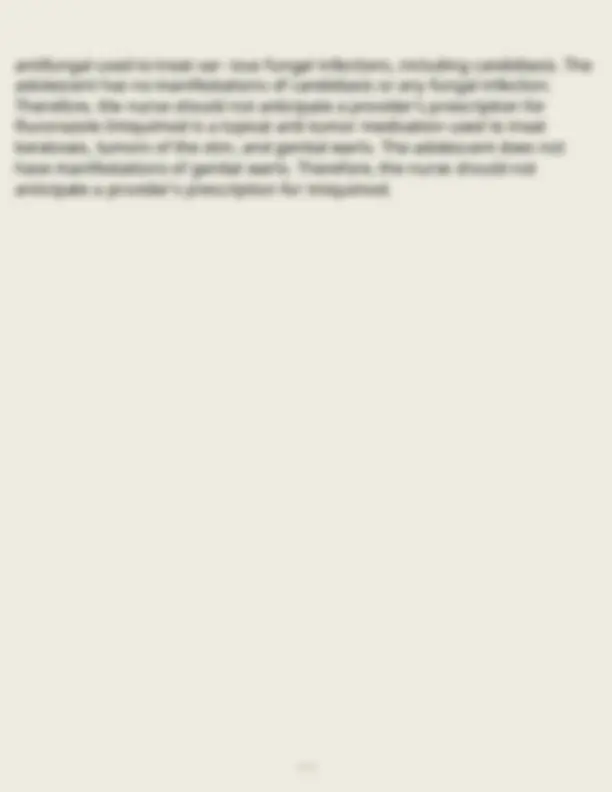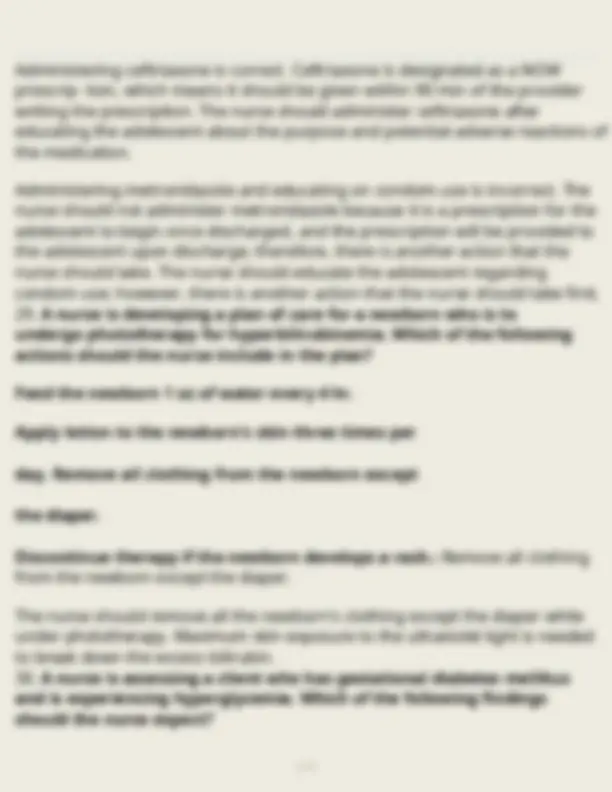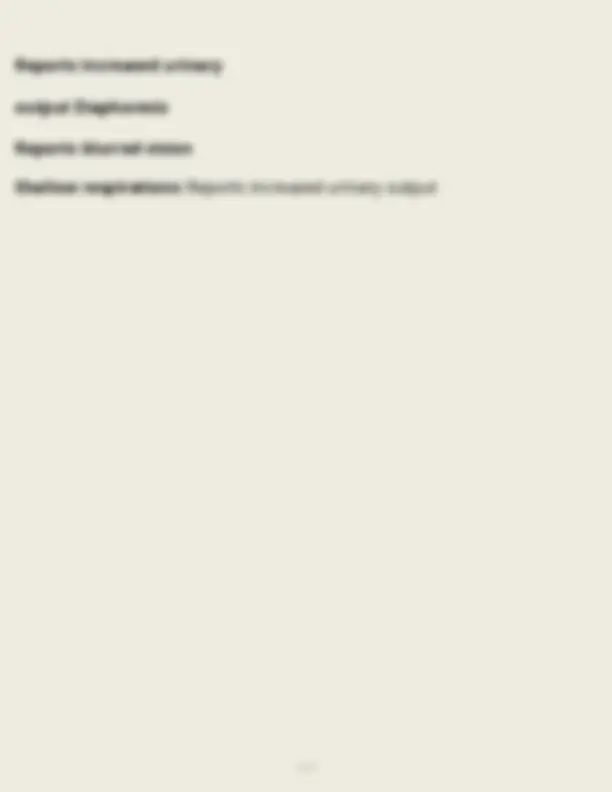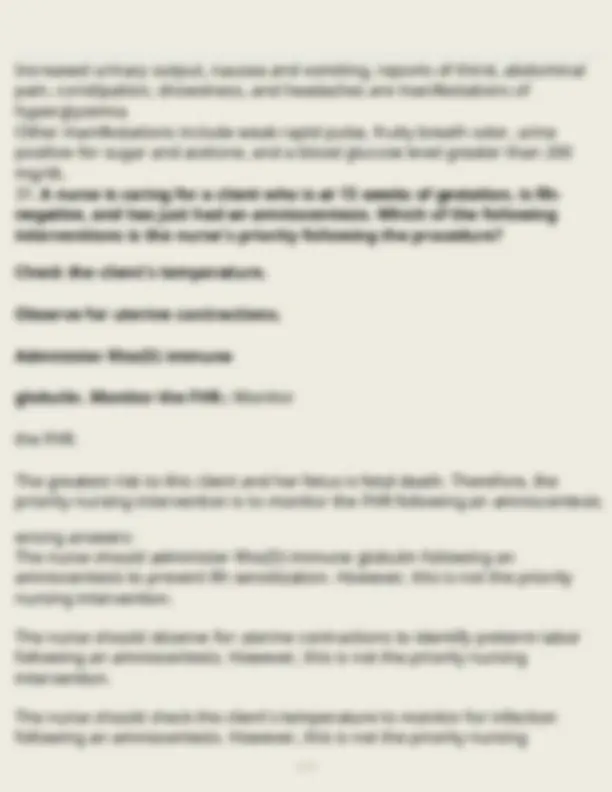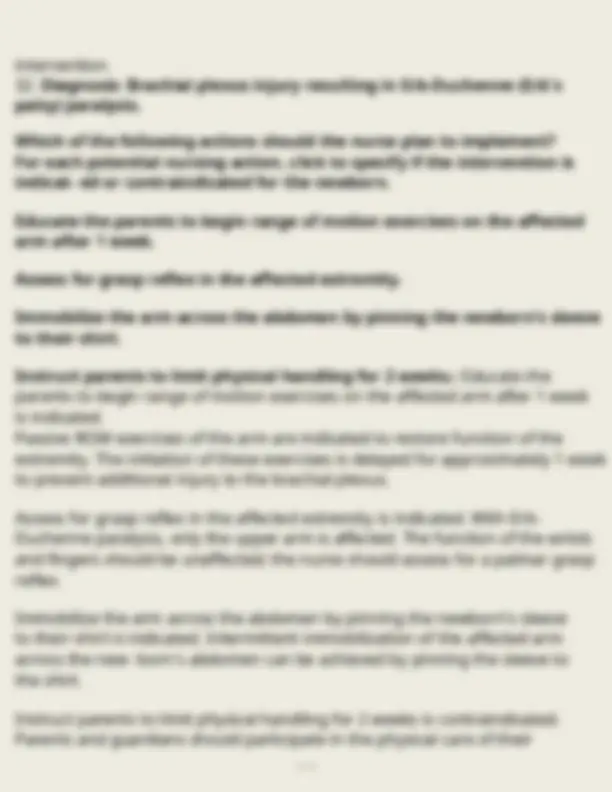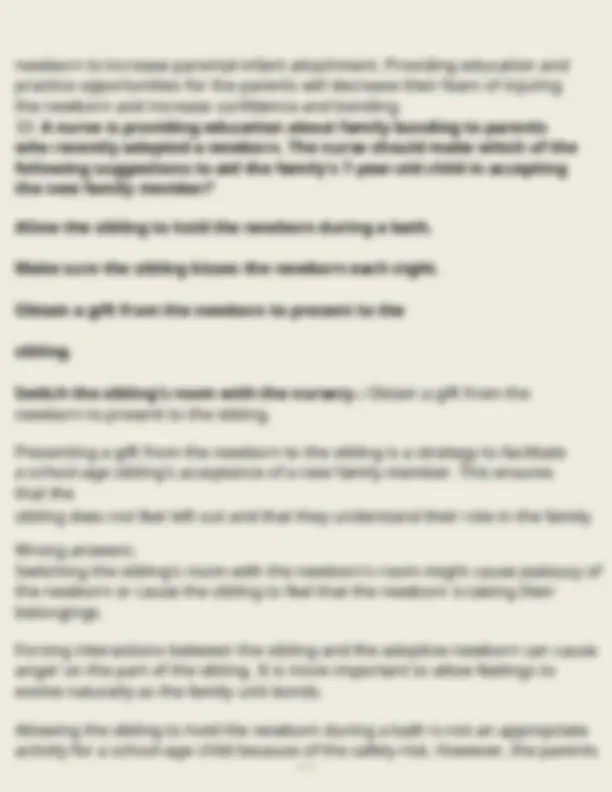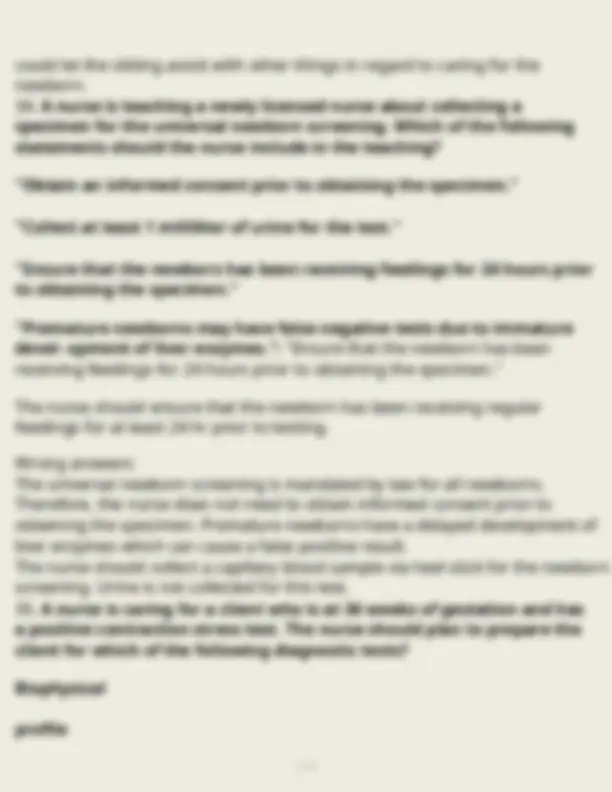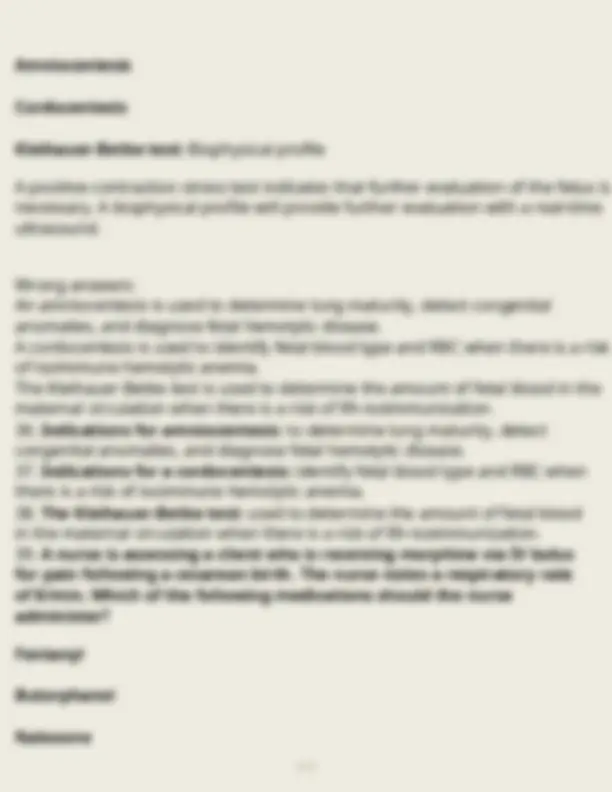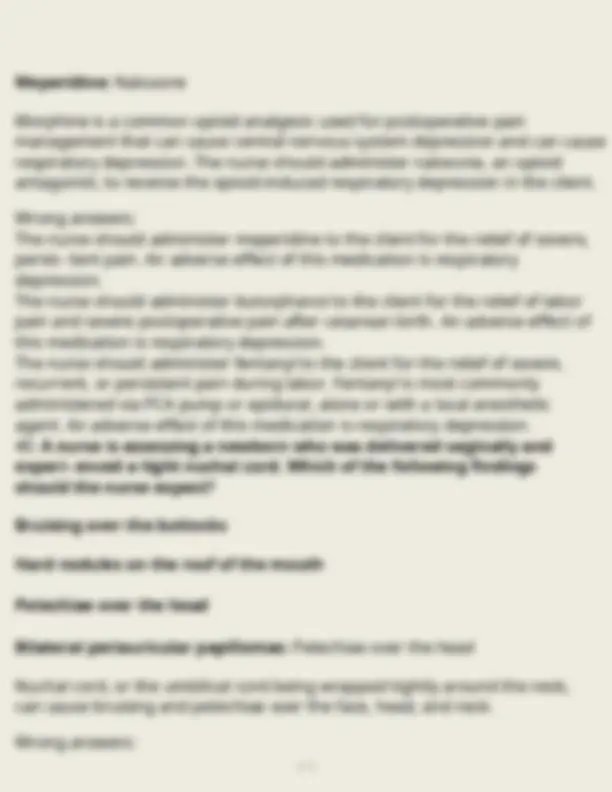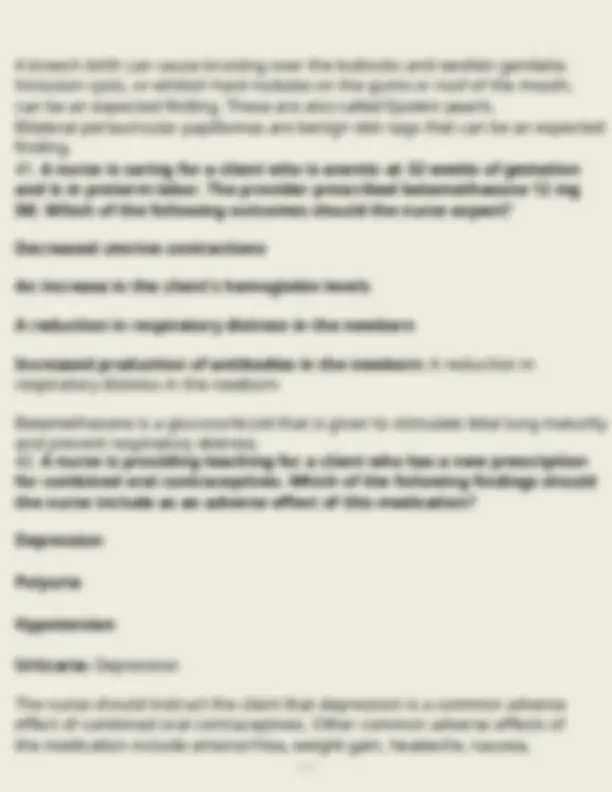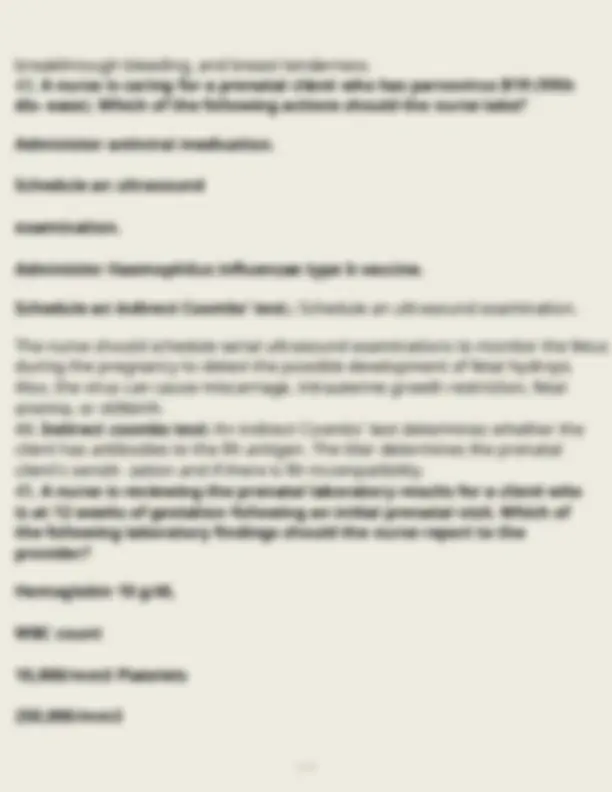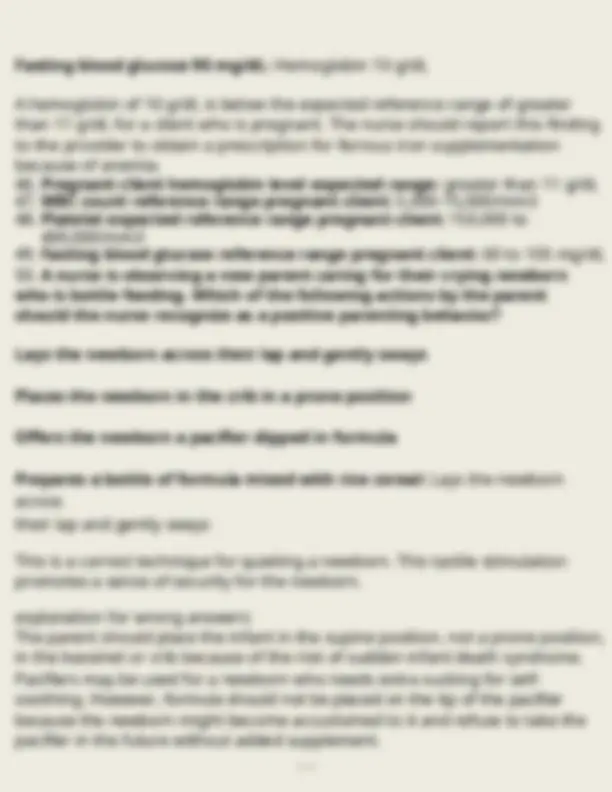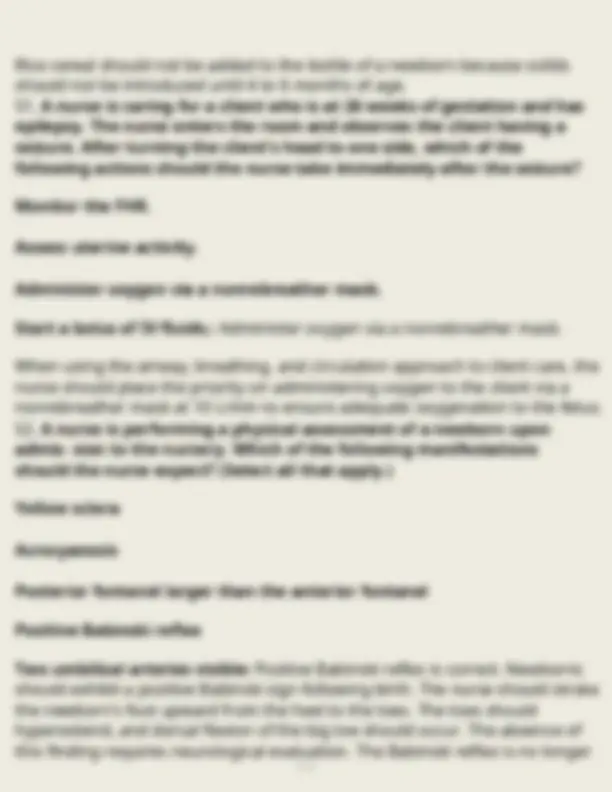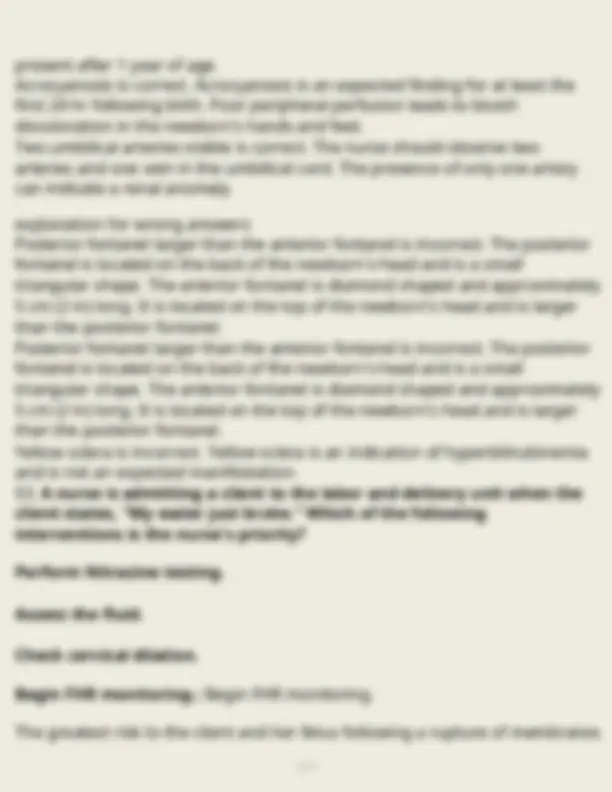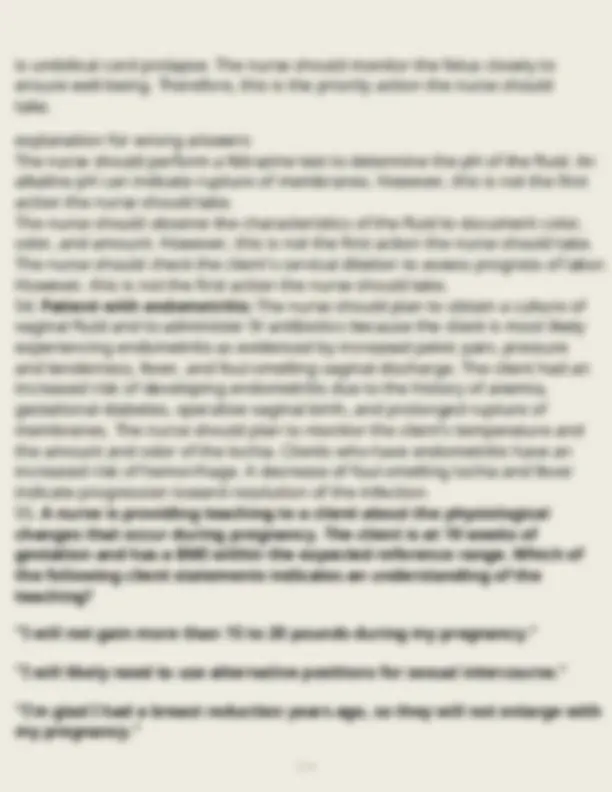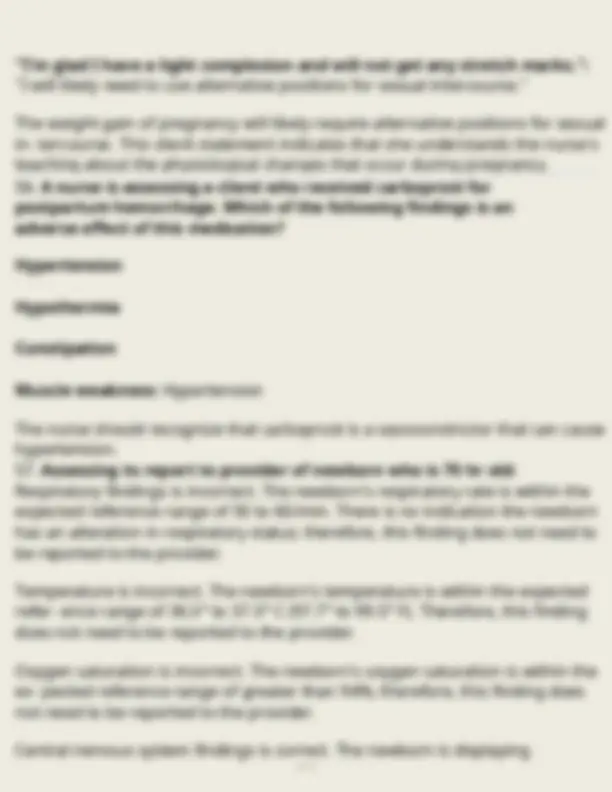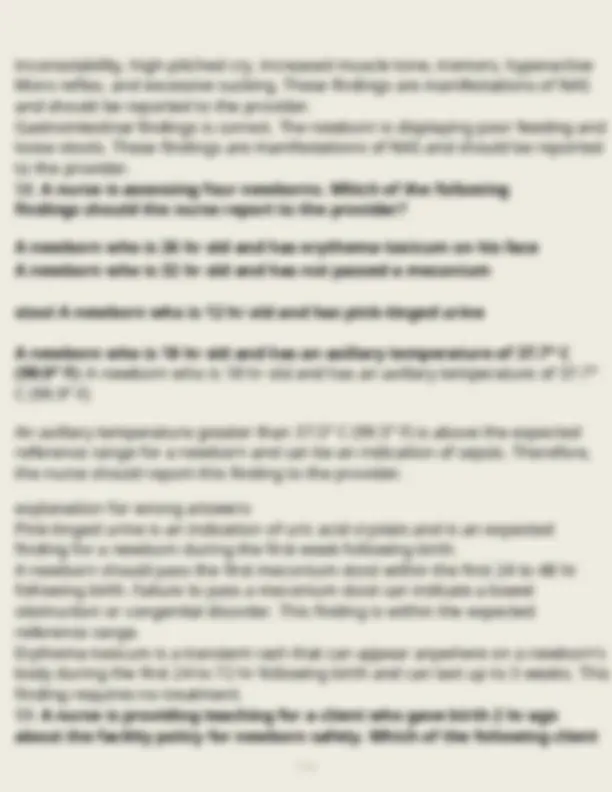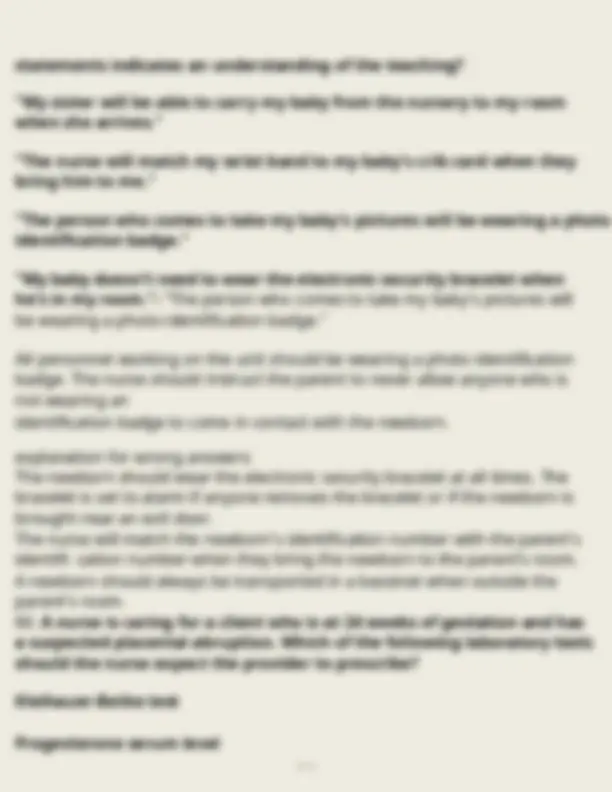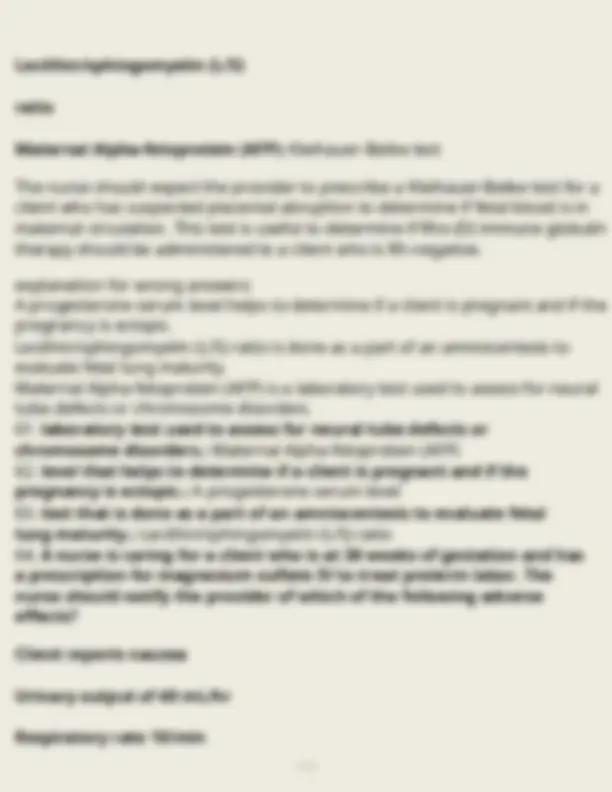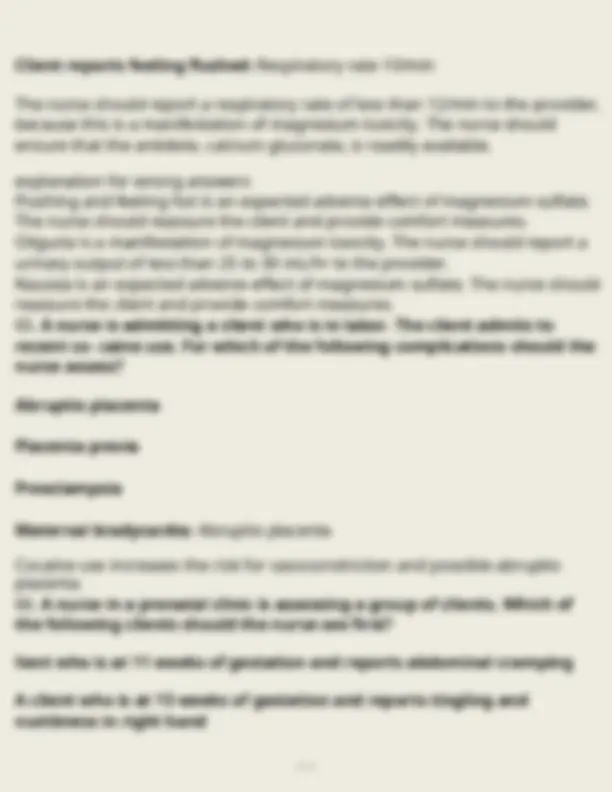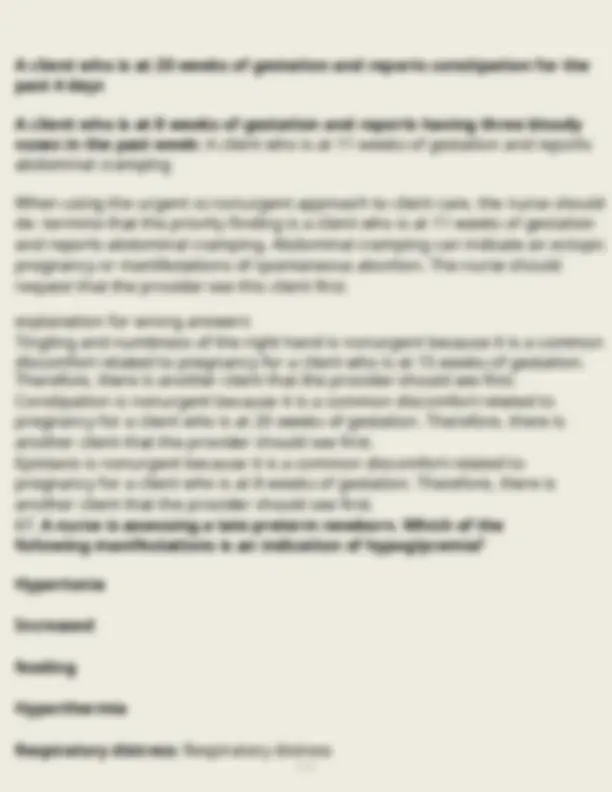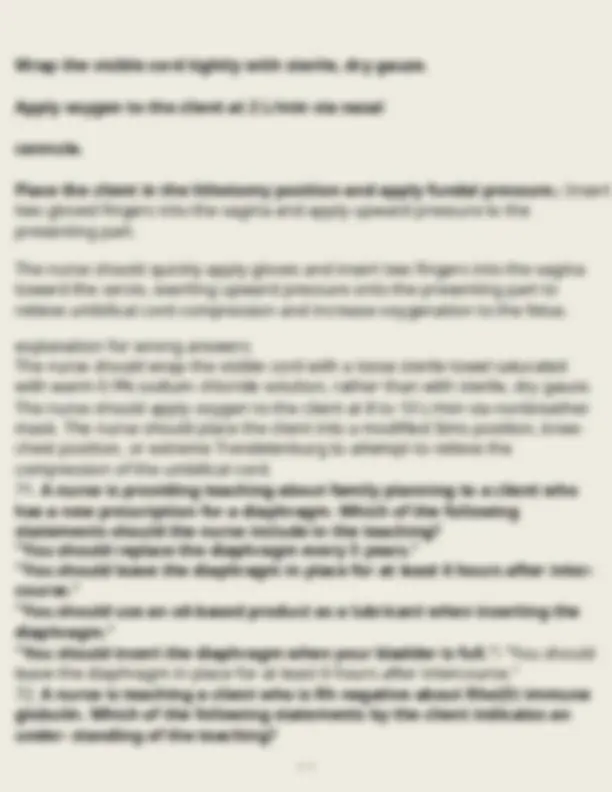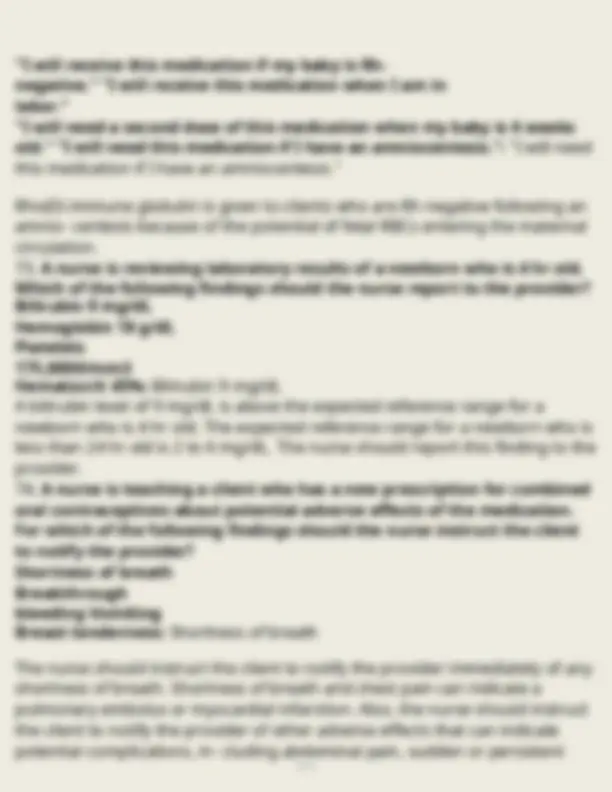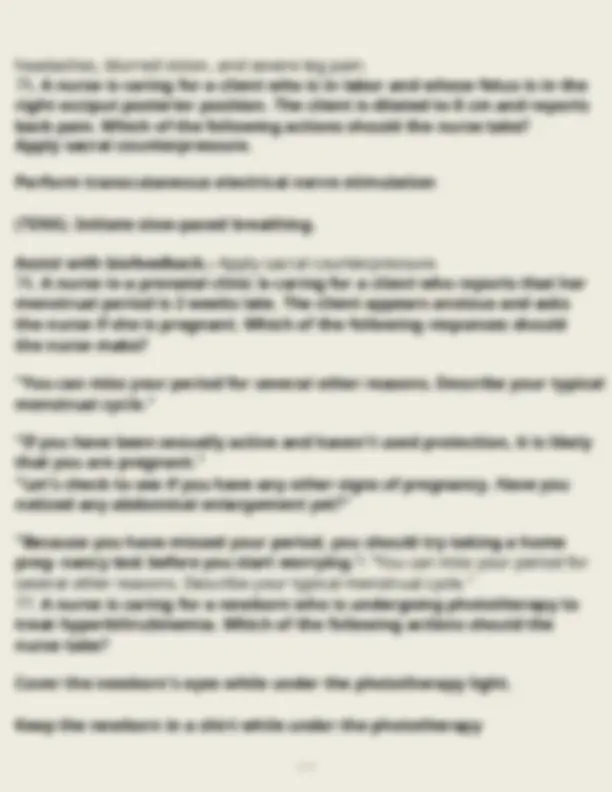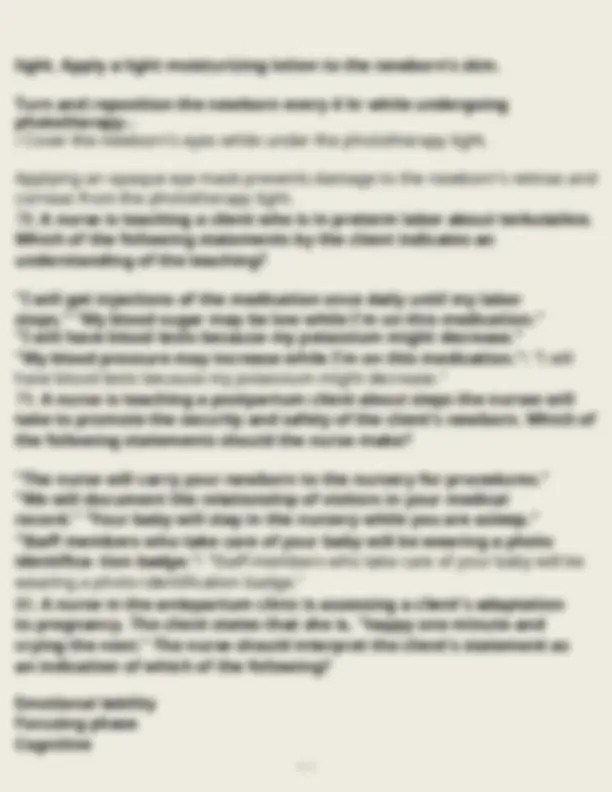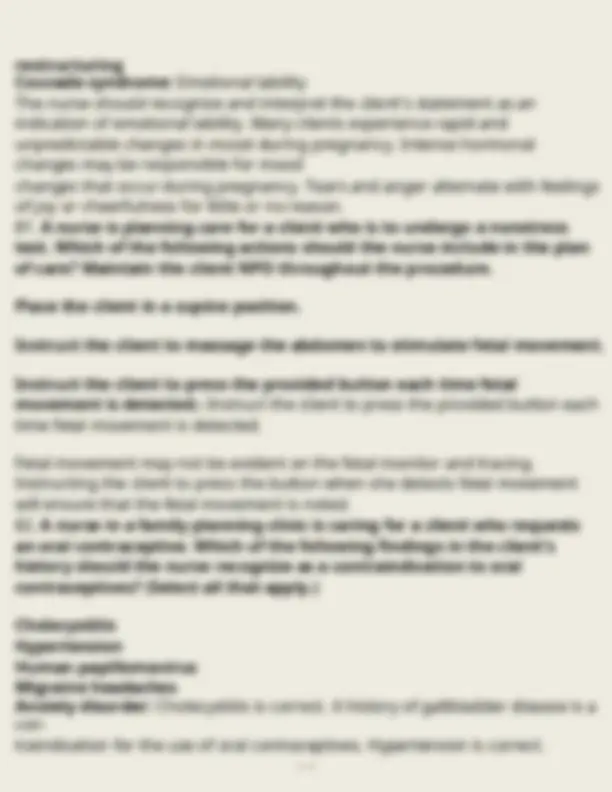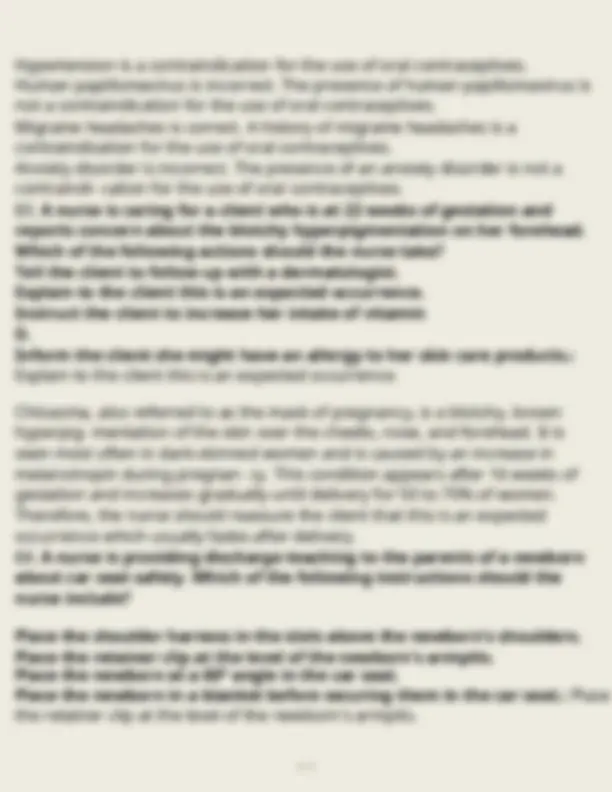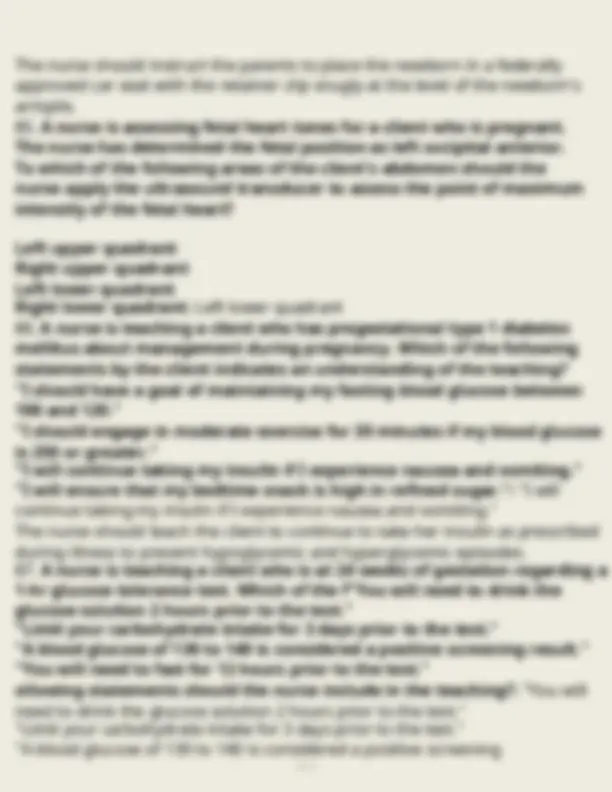Download ATI Maternal + newborn practice questions well detailed 100% correct answers updated versi and more Exams Nursing in PDF only on Docsity!
ATI Maternal + newborn practice questions well detailed
100% correct answers updated version
- A nurse is providing discharge teaching to a client who had a cesarean birth 3 days ago. Which of the following instructions should the nurse include? "You can resume sexual activity in 1 week." "You won't need to do Kegel exercises since you had a cesarean." "You can still become pregnant if you are breastfeeding." "You are safe to start adding sit-ups to your exercise routine in 2 weeks.": "You can still become pregnant if you are breastfeeding."
- A nurse is caring for a client who is experiencing preeclampsia and has a new prescription for IV magnesium sulfate. Which of the following medications should the nurse anticipate administering if the client develops magnesium toxicity? Calcium gluconate Hydralazine Medroxyprogesterone acetate
Methylergonovine: Calcium gluconate The nurse should anticipate administering calcium gluconate if the client develops magnesium toxicity. Calcium gluconate is the antidote.
- A nurse in an antepartum clinic is providing care for a client who is at 26 weeks of gestation. Upon reviewing the client's medical record, which of the following findings should the nurse report to the provider? Exhibit 1: Blood pressure 130/78 mm HgRespiratory rate 20/minHeart rate 90/min 2: Hemoglobin 12 g/dL Hematocrit 34%1-hr glucose tolerance test 120 mg/dL 3: Fundal height 30 cmGood fetal movementNot experiencing headache, dizzi- ness, blurred vision, or vaginal bleeding Fetal heart rate 110/min 1-hr glucose tolerance test Hematocrit Fundal height measurement Fetal heart rate (FHR): Fundal height measurement A fundal height measurement of 30 cm should be reported to the provider. Fundal height should be measured in centimeters and is the same as the number of gestational weeks plus or minus 2 weeks from 18 to 32 weeks gestation. Therefore, the nurse should report this finding to the provider.
- A nurse is preparing to administer magnesium sulfate 2 g/hr IV to a client who is in preterm labor. Available is 20 g magnesium sulfate in 500 mL of dextrose 5% in water (D5W). The nurse should set the IV infusion pump to administer how many mL/hr? (Round the answer to the nearest whole number. Use a leading zero if it applies. Do not use a trailing zero.): 50 mL/hr
- A nurse is teaching a client who is at 10 weeks of gestation about
Urine protein 2+ FHR 152/min: FHR 152/min The expected range for the FHR is 110/min to 160/min. The FHR is higher earlier in gestation with an average of approximately 160/min at 20 weeks of gestation. Therefore, this is an expected finding by the nurse.
- A nurse is assessing a newborn 12 hr after birth. Which of the following manifestations should the nurse report to the provider? Acrocyanosis Transient strabismus Jaundice Caput succedaneum: Jaundice Jaundice occurring within the first 24 hr of birth is associated with ABO incompati- bility, hemolysis, or Rh-isoimmunization. The nurse should report this manifestation to the provider.
- A charge nurse on a labor and delivery unit is teaching a newly licensed nurse how to perform Leopold maneuvers. Which of the following images in- dicates the first step of Leopold maneuvers?: Evidence-based practice indicates the nurse should perform this step first when performing Leopold maneuvers. During this step, the nurse palpates the client's abdomen with the palms to determine which fetal part is in the uterine fundus. This step also identifies the lie (transverse or longitudinal) and presentation (cephalic or breech) of the fetus.
- A nurse is assessing a client who is 1 day postpartum and has a vaginal hematoma. Which of the following manifestations should the nurse expect? Lochia serosa vaginal drainage
Vaginal pressure Intermittent vaginal pain Yellow exudate vaginal drainage: Vaginal pressure The nurse should expect a client who has a vaginal hematoma to report pressure in the vagina due to the blood that leaked into the tissues.
- A nurse is demonstrating to a client how to bathe their newborn. In which order should the nurse perform the following actions? Clean newborns diaper area wash the newborns neck by lifting the newborns chin wipe the newborns eyes from the inner canthus outward cleanse the skin around the newborns umbillical cord stump wash the newborns legs and feet: The nurse should demonstrate how to bathe a newborn by using a head to toe, clean to dirty, approach. Therefore, the nurse should first wipe the newborn's eyes from the inner canthus outward using plain water. The nurse should then wash the newborn's neck by lifting the newborn's chin. Next, the nurse should cleanse the skin around the umbilical cord stump followed by washing the newborn's legs and feet. The last step of the bath should be to clean the newborn's diaper area.
- A nurse is creating a plan of care for a client who is postpartum and adheres to traditional Hispanic cultural beliefs. Which of the following cultural practices should the nurse include in the plan of care? Protect the client's head and feet from cold
FHR: Prolonged deceleration of fetal heart rate to 90/min, minimal variabili- ty.: Administer a bolus of IV fluids is correct. A priority intervention that the nurse should perform when using the urgent vs. nonurgent approach to client care is to address the client's hypotension and fetal bradycardia and minimal variability. The nurse should plan to administer a bolus of IV fluids to increase the client's blood volume and improve uterine and intervillous space blood flow. Reposition the client to their side is correct. A priority intervention that the nurse should perform when using the urgent vs. nonurgent approach to client care is to address the fetal bradycardia and minimal variability caused by decreased utero- placental perfusion. The nurse should plan to turn the client to their side to increase cardiac output and improve uterine and intervillous space blood flow. Apply oxygen at 10 to 12 L/min by nonrebreather mask is correct. A priority interven- tion that the nurse should perform when using the urgent vs. nonurgent approach to client care is to address the fetal bradycardia and minimal variability caused by decreased uteroplacental perfusion. The nurse should plan to administer oxygen via nonrebreather mask to increase maternal circulating oxygen levels and improve oxygen transfer through the intervillous spaces to the fetus. Elevate the client's legs is correct. A priority intervention that the nurse should perform when using the urgent vs. nonurgent approach to client care is to address the client's hypotension and fetal bradycardia and minimal variability. Elevating the client's legs will promote blood return to the heart and increase cardiac output. This action will improve uterine and intervillous space blood flow.
- A nurse is caring for a client who is at 38 weeks of gestation. Which of the following actions should the nurse take prior to applying an external transducer for fetal monitoring? Determine progression of dilatation and effacement.
Perform Leopold maneuvers. Complete a sterile speculum exam. Prepare a Nitrazine paper test.: Preform Leopold maneuvers The nurse should perform Leopold maneuvers to assess the position of the fetus to best determine the optimal placement for the external fetal monitoring transducer.
- A nurse is providing teaching to a client who is at 40 weeks of gestation and has a new prescription for misoprostol. Which of the following instructions should the nurse include in the teaching? "I can administer oxytocin 4 hours after the insertion of the medication." "You will need a full bladder prior to the insertion of the medication." "Remain in a side-lying position for 15 minutes after the medication is insert- ed." "An antacid will be given 20 minutes prior to the insertion of the medication."- : "I can administer oxytocin 4 hours after the insertion of the medication." The nurse can administer oxytocin no sooner than 4 hr after the last dose of misoprostol. Oxytocin can be administered following misoprostol for clients who have cervical ripening and have not begun labor.
- A nurse is providing teaching about nonpharmacological pain manage- ment to a client who is breastfeeding and has engorgement. The nurse should recommend the application of which of the following items? Cold cabbage leaves Purified lanolin cream
The nurse should verify the newborn's identity every time the newborn is returned to the parents. The nurse should match the information on the parent's identification band to the information on the newborn's identification band.
- A nurse is caring for a client who is to receive oxytocin to augment her labor. Which of the following findings contraindicates the initiation of the oxytocin infusion and should be reported to the provider? Late decelerations Moderate variability of the FHR Cessation of uterine dilation Prolonged active phase of labor: Late decelerations Late decelerations are indicative of uteroplacental insufficiency. Therefore, this is a contraindication for the administration of oxytocin and should be reported to the provider.
- A nurse is assessing a client who is at 38 weeks of gestation during a weekly prenatal visit. Which of the following findings should the nurse report to the provider? Blood pressure 136/88 mm Hg Report of insomnia Weight gain of 2.2 kg (4.8 lb) Report of Braxton Hicks contractions: Weight gain of 2.2kg (4.8lbs) A weight gain of 2.2 kg (4.8 lb) in a week is above the expected reference range and could indicate complications. Therefore, this finding should be
reported to the provider.
- A nurse is assessing a newborn who was born at 26 weeks of gestation using the New Ballard Score. Which of the following findings should the nurse expect? Minimal arm recoil
Client reports cramping and lower back pain that started this morning. Client denies leaking fluid. Nurses' Notes
0900:Client placed on electronic fetal monitor. Client reports pain as 4 on a scale of 0 to 10. 1000: FHR assessment 150/min. Average variability. No decelerations. Spontaneous accelerations noted.Uterine contractions occurring every 2 min, lasting 40 to 60 seconds in duration. Palpate as moderate intensity.Vaginal examination performed. Cervix is 2 cm dilated and 50% effaced.: Uterine contractions is correct. The client is experiencing regular uterine contractions and cervical change, which are indicators of preterm labor; therefore, the nurse should notify the provider about this finding. Gestational age is correct. The client is at 32 weeks of gestation and is experiencing regular uterine contractions and cervical dilation, which indicates that the client is in preterm labor; therefore, the nurse should notify the provider about this finding. Vaginal examination is correct. The client's cervix is dilated to 2 cm and is 50% effaced, which indicate the client is in preterm labor; therefore, the nurse should notify the provider about this finding.
- A nurse is caring for a client who has hyperemesis gravidarum and is receiving IV fluid replacement. Which of the following findings should the nurse report to the provider? BUN 25 mg/dL Serum creatinine 0.8 mg/dL Urine output of 280 mL within 8 hr Urine negative for ketones: BUN 25mg/dL The nurse should report an elevated BUN to the provider since it can indicate dehydration.
- A nurse in a provider's office is reviewing the medical record of a
-Vaginal discharge -Heart rate
- Temperature
- Dyspareunia -Condom usage A nurse in a clinic is caring for a 16-year-old adolescent: History and Physical Adolescent is sexually active with two current partners. IUD in place Reports not using condoms during sexual activity. History of type 1 diabetes mellitus Nurses' Notes 1300:Admitted adolescent reporting "cramping in my stomach." Reports pain as a 4 on 0 to 10 pain scale and describes pain as constant and dull. Re- ports nausea and vomiting over past 24 hours.Reports painful urination and pain during sexual intercourse with minimal vaginal itching.Tenderness with palpation to lower abdomen, guarding abdomen observed. Greenish vaginal discharge observed. Reports last menstrual period was 3 weeks ago as normal period lasted 4 days. Vital Signs 1300:Blood pressure 118/72 mm Hg Heart rate 100/min Respiratory rate 20/min Temperature 38.3° C (101° F) Provider Prescriptions 1300:Standing prescriptions for clients who present with abdominal pain: Obtain laboratory tests: Urinalysis Cervical culture
C-reactive protein Beta hCG: Abdominal assessment is correct. Abdominal tenderness with palpation is not an expected finding with an abdominal assessment; therefore, the nurse should report this finding to the provider. Vaginal discharge is correct. Greenish vaginal discharge indicates that the adoles- cent has an infection, which is not an expected finding; therefore, the nurse should report this finding to the provider. Temperature is correct. The client's temperature of 38.3° C (101° F) is above the expected reference range. An elevated temperature could signal infection or inflammation; therefore, the nurse should report this finding to the provider. Dyspareunia is correct. Dyspareunia is painful intercourse, which can be associated
abdom- inal pain on one side, vaginal spotting or bleeding, and a delayed menstrual period. The adolescent reports having a normal menstrual period 3 weeks ago. The beta hCG test was negative and there are no other indications that the adolescent has an ectopic pregnancy; therefore, there is another condition the adolescent is most likely developing.
Pyelonephritis is incorrect. Pyelonephritis is an inflammation of the upper urinary tract and kidneys and usually develops following a bladder infection. It is charac- terized by fever, flank pain, dysuria, and urgency. The adolescent's urinalysis has a negative leukocyte esterase and an absence of white blood cells and bacteria. These findings do not indicate the presence of a bladder infection; therefore, there is another condition the adolescent is most likely developing C-reactive protein is correct. The adolescent's C-reactive protein is elevated, which is a manifestation of PID. Beta hCG level is incorrect. The beta hCG test was negative and there are no other indications the adolescent has an ectopic pregnancy; therefore, there is another condition the adolescent is most likely developing Urinalysis is incorrect. The adolescent's urinalysis has a negative leukocyte esterase and an absence of white blood cells and nitrites. These findings do not indicate the presence of a bladder infection; therefore, there is another condition the adolescent is most likely developing.
- Treatment for STIS: Ceftriaxone and doxycycline are correct. Ceftriaxone is an anti-infective used to treat a variety of infections, including gonorrheal infection. Cef- triaxone is administered as a one-time IM injection for the treatment of gonorrhea. The adolescent is exhibiting manifestations of a gonorrheal infection. Therefore, the nurse should anticipate a provider's prescription for ceftriaxone. Doxycycline is an anti-infective used to treat a variety of infections. Doxycycline and ceftriaxone are anti-infectives used in the treatment of mild to moderate PID. The adolescent is exhibiting manifestations of a gonorrheal infection and PID. Therefore, the nurse should anticipate a provider's prescription for doxycycline. Acyclovir, fluconazole, and imiquimod are incorrect. Acyclovir is an antiviral used to treat herpes infections by interfering with the virus' DNA synthesis. The adolescent has no manifestations of genital herpes. Therefore, the nurse should not anticipate a provider's prescription for acyclovir. Fluconazole is an

